When used correctly, B2B marketing attribution can help you track what touchpoints are generating the most value, make budgetary decisions based on actionable data, and more importantly, scale the profitably of your marketing campaigns.
For most B2B companies, marketing is a sizable expense and leaders want to know what they’re getting for their buck. In a survey we found that 55% of marketers are tasked with the responsibility of increasing ROI.
Company leaders are no longer satisfied by performance indicators such as clicks, conversions and downloads. They want to know:
1. What marketing initiatives are having the biggest impact on the bottom line.
2. How you’re going to use this insight to drive more lucrative opportunities.
We’ve come a long way in terms of analytics and marketing attribution, and yet so many marketers are struggling with end-to-end tracking and consider measuring marketing ROI a challenge.
In fact, only 17% of advertisers look at the performance of their digital channels holistically.
Well, that’s about to change.
With a better grasp of B2B marketing attribution, it will become easier to identify which of your marketing activities are having the biggest impact on conversions, and more importantly, revenue.
For this article, we’ll discuss:
Without further ado, let’s jump in.
💡 Pro Tip
Gain a better understanding of what attribution modelling is and how it can help you in the era of multi-touch customer journeys by downloading our free eBook.
Download the complete guide to marketing attribution
Marketing attribution allows you to see how well individual channels are performing, how they relate to overall marketing ROI, and, more importantly, lets you make decisions based on actionable data. Attribution is an essential component of any targeted B2B marketing strategies.
Related: What is marketing attribution? The definitive guide
It provides you with a more sophisticated approach than simple click tracking to follow your customers’ journey and attribute credit to the marketing initiatives that played a significant part across the path-to-purchase.
Due to its popularity, there’s been an explosion of attribution models designed to help B2B businesses track and analyse customers throughout the entire customer journey.
Related: Guide to customer journey stages and how to track them
💡 Pro Tip
Tracking customer interactions across multiple channels unlocks powerful insight which you can use to improve your customer experience and marketing efforts. Get your guide on how to track customer journeys and learn how to follow the complete lifecycle from awareness to decision.
Download the guide on tracking customer touchpoints
Marketing attribution models are frameworks that accurately identify how and where your leads and customers engage with your marketing channels and generally fall into two categories:
Single-touch attribution: This type of attribution allocate 100% revenue credit to a single campaign or channel. Typically, these attribution models assign conversion values to either the first or last touchpoint a visitor interacted with before making a conversion.
Multi-touch attribution: On the other hand, multi-touch attribution allows marketers to analyse the entire conversion path with more clarity. The purpose of multi-touch attribution is to optimise the allocation of your marketing budget so that you can focus on the channels that have the most impact on conversions and revenue.
To help explain the following attribution models, we’ll refer to a sample of a buyer’s journey.

Now, that’s out of the way, let’s take a look at some of the most common attribution models used by marketers:
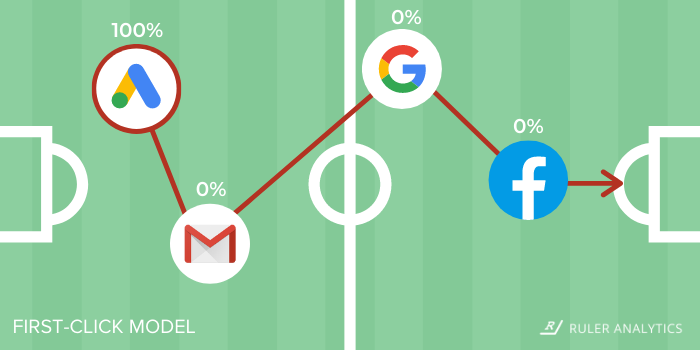
100% of the credit for the conversion is allocated to the user’s first interaction. The first-click model has attributed all of the revenue from the sale to the Google ad that inspired the journey.
Related: A complete guide to first-click attribution
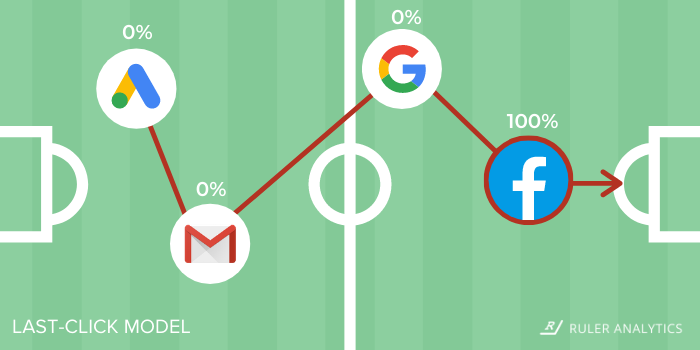
100% of the credit for the conversion is allocated to the user’s last interaction before they convert into a sale. The last click model has attributed all of the revenue from the sale to the retargeting ad on Facebook.
Related: Marketers guide to last-click attribution
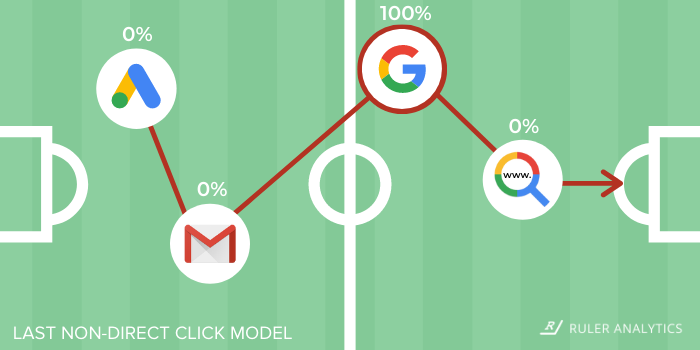
For this model, we’ve slightly altered the customer journey. Similar to the last click model, although 100% credit is allocated to the second to last touchpoint the user engaged with.
The last non-direct click model has assigned 100% of the credit to the organic visit and ignored the direct touchpoint.
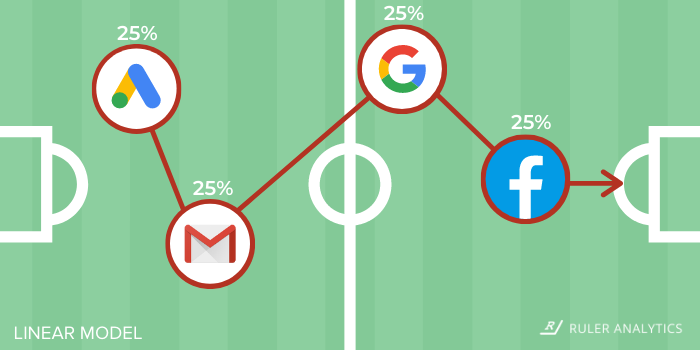
The credit for the conversion or sale is distributed evenly across each channel a buyer interacted with through the entire buying journey.
The linear attribution model has divided all of the revenue from the sale equally across the entire conversion path.
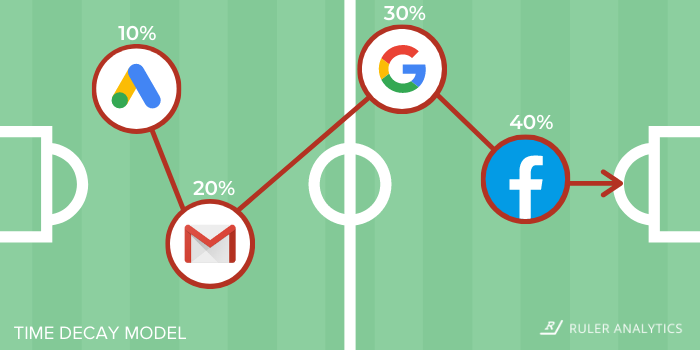
The revenue from the sale is distributed to all marketing touchpoints, but the most recent touchpoints receive a higher percentage of credit. Time decay has attributed the credit to all of the touchpoints.
However, the touchpoints nearer the conversion have received more credit than the earlier touchpoints.
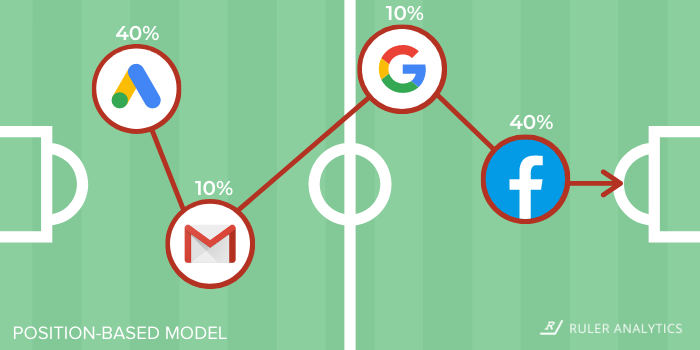
The first and last touchpoints both receive 40% of the credit for a conversion and the remaining 20% is spread evenly across any touchpoints in the middle of the journey.
Position-based has allocated 40% credit to the Google ad and Facebook ad. The remaining touchpoints share the remaining 20% credit.
Attribution isn’t just for the digital world. It can also include offline marketing efforts, traditional advertising, and non-marketing related variables.
Offline attribution is specifically beneficial for businesses that sell high-value products or operate in the service industry and use digital marketing to drive engagement offline.
Related: Measure the impact of your marketing with offline attribution
In a study, we asked marketers to score on a scale of 0 to 5 how easy it is to attribute offline sales to online leads.
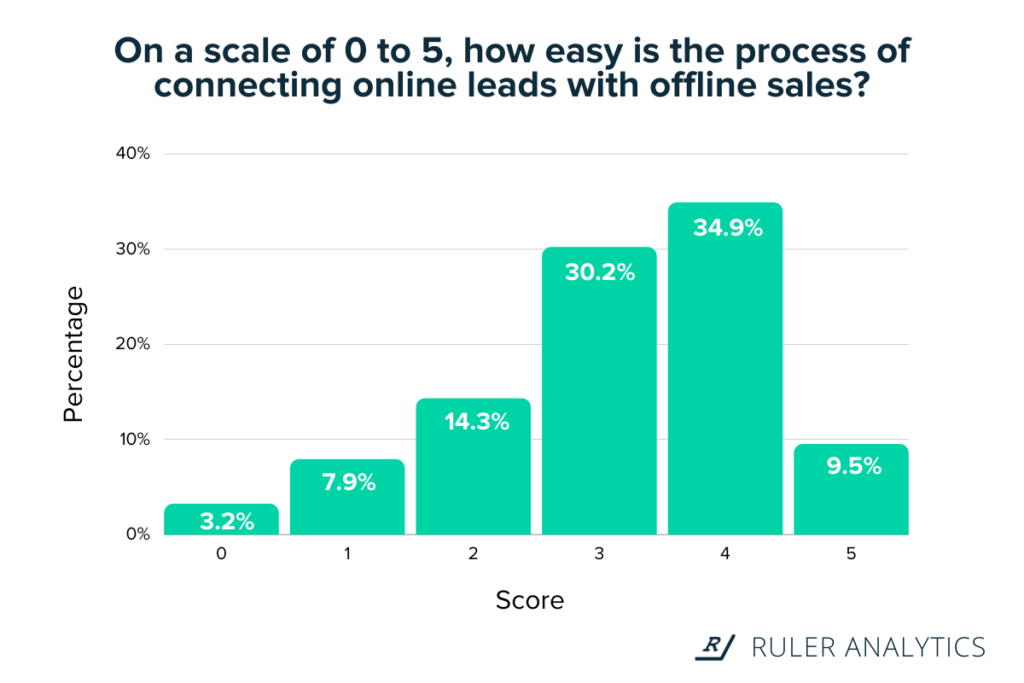
44.4% of marketers scored the process coordinating online and offline touchpoints a score of 4 and over, a clear indication that offline attribution still proves to be a challenge for most marketers despite the growth in analytical software.
If you are facing difficulties with marketing, you’re not alone.
In a survey, respondents ranked “minimal understanding and skills”, “lack of tools and applications” and “cross channel journeys” the top three marketing attribution challenges.
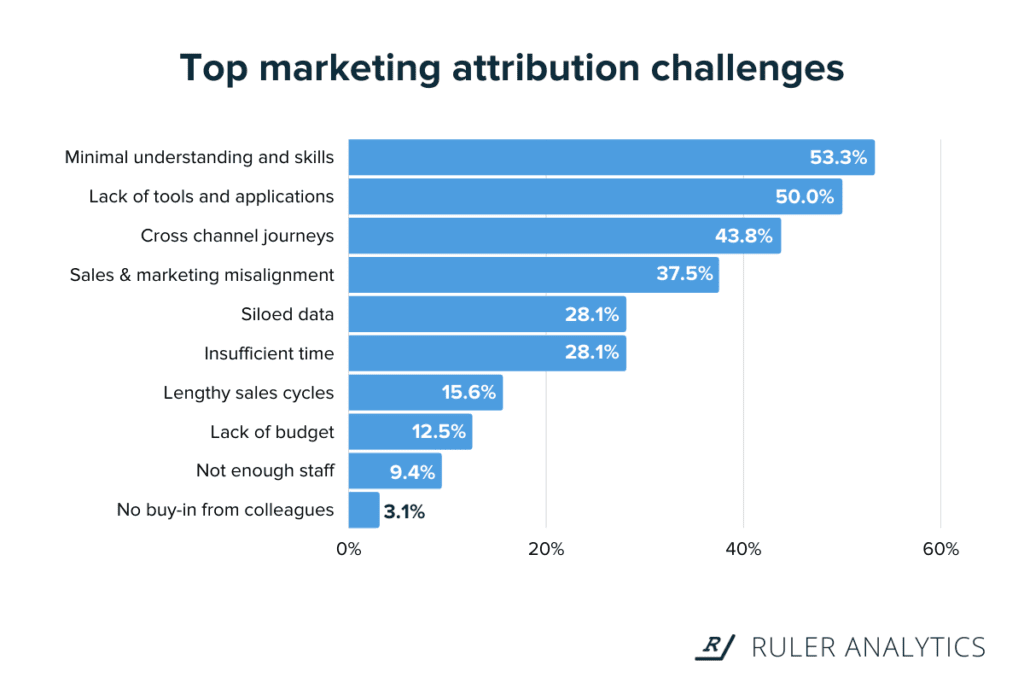
More than half of respondents agreed that a lack of skills and knowledge was the main barrier to successful lead tracking.
While it may seem straightforward, manually tracking leads from start to finish generally involves many moving parts.
It requires a lot of skill, coordination and time that most sales and marketing teams don’t have.
If we’ve learned anything as a provider of multi-touch attribution, it’s that lead tracking is extremely difficult, if not impossible, without the right tools at hand.
Our survey found that half of companies lack the right tools and applications to track leads throughout different stages of the customer journey.
Despite the availability of technology, many businesses still rely on manual labour to enter leads into their databases. Manual data entry is slow, inaccurate and extremely time-consuming.
That’s why lead tracking tools like Ruler Analytics are a buried treasure for businesses.
Related: 8 lead tracking and management software for 2022
They allow support, sales and marketing teams to track lead activity throughout each stage of the customer journey and determine which channels contribute the most qualified traffic and leads.
Lead tracking has never been easy, and the increase in digital communication channels has made things even harder for marketers.
💡 Pro Tip
Ruler makes the process of lead tracking much easier. t tracks data on a visitor level, allowing you to successfully attribute leads and marketing-generated revenue across multiple campaigns, ads, keywords and more.
Track where your leads came from with Ruler
According to Think with Google, users could have up to 20 touchpoints with your content before converting into a customer.
And, during our own study, we also found that nearly 20% of companies have sales cycles greater than four months.
So, what makes cross-channel journeys so difficult?
Well, most marketers will use Google Analytics to track leads.
Google Analytics does a great job of showing you the start and end of a visitor’s journey, but the middle usually gets a little fuzzy.
Related: 6 ways to effectively track leads in Google Analytics
What’s more, is that Google Analytics has a lookback window of 90-days.
So, if you’re one of those companies that have an average sales cycle longer than four months, you’re likely missing out on valuable lead and marketing source data.
How you attribute credit will depend on your industry and the length of your sales cycle.
Related: What is a Sales Cycle? (+ 27 tips to close deals and revenue faster)
For us, and many other businesses, the following stages are considered the most crucial touchpoints in a customer journey:
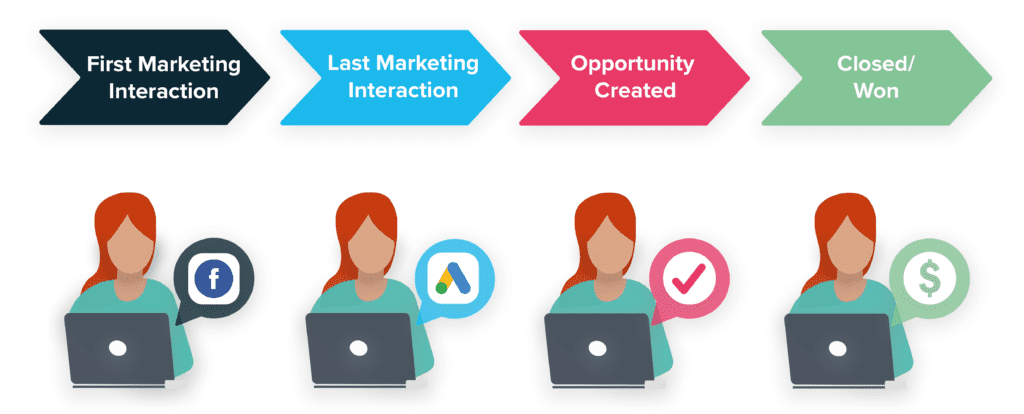
We’re not saying that you can’t focus on other touchpoints, again this depends on your unique circumstances. Although, for most companies, it’s these stages that have the most impact on the customer journey.
Related: Guide to customer journey stages and how to track them
Now let’s take a look at some techniques to help you track these touchpoints and improve your overall B2B marketing attribution.
Traditionally, sales and marketing operate as two separate functions.
Marketing will focus on delivering the most traffic and leads.
Sales, on the other hand, will concentrate on nurturing and closing as many deals as possible.
As simple as this may appear, this practice is outdated and can lead to conflict between both teams.
Sales will often point the blame at marketing for sending rubbish leads that take up all their time and resources.
Marketing, however, will argue that sales aren’t working hard enough to convert leads.
Arguably, the easiest way to break down the barrier between marketing and sales is by providing intelligence into how, where and when your marketing efforts influenced a lead or revenue.
And this is where closed-loop marketing steps in.
Closed-loop marketing creates a cycle of data between all your teams. It allows you to pinpoint the lead generation techniques that drive the most (and the least) revenue.
Related: What is closed-loop marketing and how to get started
More importantly, it allows your sales and marketing teams to collaborate and set goals towards revenue generation and focus on the channels that have the greatest impact on the bottom line.
Closed-loop marketing can be achieved using the four steps below:
💡 Pro Tip
Want more information? We recommend downloading our eBook on closed-loop marketing for a more comprehensive step-by-step guide.
Grab your copy for the closed-loop marketing attribution guide
In order to set up closed-loop marketing successfully, you’ll need to be able to map your marketing touchpoints with closed/won deals.
Related: Improve your customer with marketing touchpoint mapping
The best way to do this is by using lead tracking software and a customer relationship management (CRM) system. Or, if you don’t have a CRM, then Google Sheets will also do the trick.
Related: How to use Google Sheets to track sales leads
Access to a good lead tracking tool and CRM software will allow your sales and marketing teams to map every touchpoint across the entire customer journey—from initial awareness to the point of conversion.
For example, Ruler tracks each anonymous visitor over multiple sessions, traffic sources and keywords.
Related: How to view full customer journeys with Ruler Analytics
Eventually, some of those anonymous visitors provide information about themselves. They fill out a form, make a phone call, or request a demo.
Ruler updates the data it collected when the prospect was anonymous, creating a journey map for what is now a known prospect.
Next, Ruler automatically passes all the marketing and conversion data it’s collected to the CRM, allowing sales and marketing to see what specific products, services, and lead sources contribute the most value to the pipeline.
When a lead is marked as won/closed, a pre-built integration passes real conversion and revenue data back to Ruler Analytics.
Related: How businesses use Ruler to track and improve ROI
Now, marketing teams can see revenue and conversion data alongside all of their traditional metrics.
💡 Pro Tip
Want more information on Ruler and the services we offer? Grab our comprehensive guide on how Ruler works and see how it can boost the quality of your marketing measurement.
Why you need Ruler Analytics
What works for one business might not work for yours.
Also, attribution isn’t something you can set up once. As your business develops, so will your objectives.
You must adjust your attribution to reflect your updates and stay ahead of the curve.
However, when you implement a solution that can help you collect and filter your lead generation data, you can move forward to improve your campaign performance, reduce waste, and prove how your efforts are building revenue for your businesses.
Want to learn more about marketing attribution? Book a call with one of our sales representatives and start focusing on the revenue impact of your marketing initiatives.
This article was originally published in 2020 and last updated on 26th April 2022 for freshness.